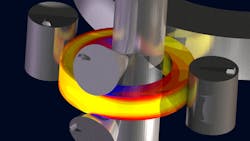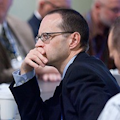Simufact Engineering recently introduced Simufact.forming 11, the latest version of its simulation software for forming processes, including forging and ring rolling. A new version of the developer’s Simufact.welding software, and both produces reportedly offer more functionality for a broader range of applications, but simplified for easier use by manufacturing operators. “With the new Simufact software releases, companies aiming to link various production processes in the process chain (from semi-finished material to finished component) have come closer to their goal of an integrated, cross-process approach in the simulation of entire process chains,” the supplier stated.
Simufact simulation programs cover a range of production processes from forging to cold forming, rolling, sheet metal forming, mechanical joining, heat treatment, and welding. Standard interfaces allow customers to achieve fast and reliable integration to their CAD/CAE platforms. An important new development is Simufact’s integration of material data in the simulation of forming and joining processes: Simufact.forming 11 not only offers numerous new, experimental material data, but it also provides access to high-quality analytical material data, ensuring accurate simulation results.
Simufact.forming 11 includes new modules for open-die forging and ring rolling. Application-specific functionalities like fully automated processing of a complete pass schedule in open-die or radial forging, and the consideration of the manufacturer’s kinematic concepts in ring rolling, help the user to model and simulate all possible processes and conditions of these production processes.
Thanks to new possibilities in result-dependant, force- and path-controlled processing, as well as an optional, method-related calculation of the structural transformation during forging, these new special modules are critical tools for companies that use ring rolling and open die forging.
Release 11 is particularly notable for joining experts, the developer states, because it takes adhesives and high-speed effects into consideration, which are gaining importance in modern joining technology.
By offering improved possibilities for networking and evaluation, Simufact.forming 11 eases the engineer’s tasks for tool and process development. The “optimization” feature allows simple testing of process options and promises substantial time savings for defining best process design. Highlights include the flexible description of thermo-physical boundary and initial conditions, and the automated reporting in pre- and post-processing.
The efficient simulation of realistic heat-treatment processes provides for more flexibility and realism in mapping the process chain, before, during, and after the forming process.
About the Author
Robert Brooks
Editor/Content Director - Endeavor Business Media
Robert Brooks has been a business-to-business reporter, writer, editor, and columnist for more than 20 years, specializing in the primary metal and basic manufacturing industries. His work has covered a wide range of topics including process technology, resource development, material selection, product design, workforce development, and industrial market strategies, among others.
Currently, he specializes in subjects related to metal component and product design, development, and manufacturing—including castings, forgings, machined parts, and fabrications.
Brooks is a graduate of Kenyon College (B.A. English, Political Science) and Emory University (M.A. English.)

